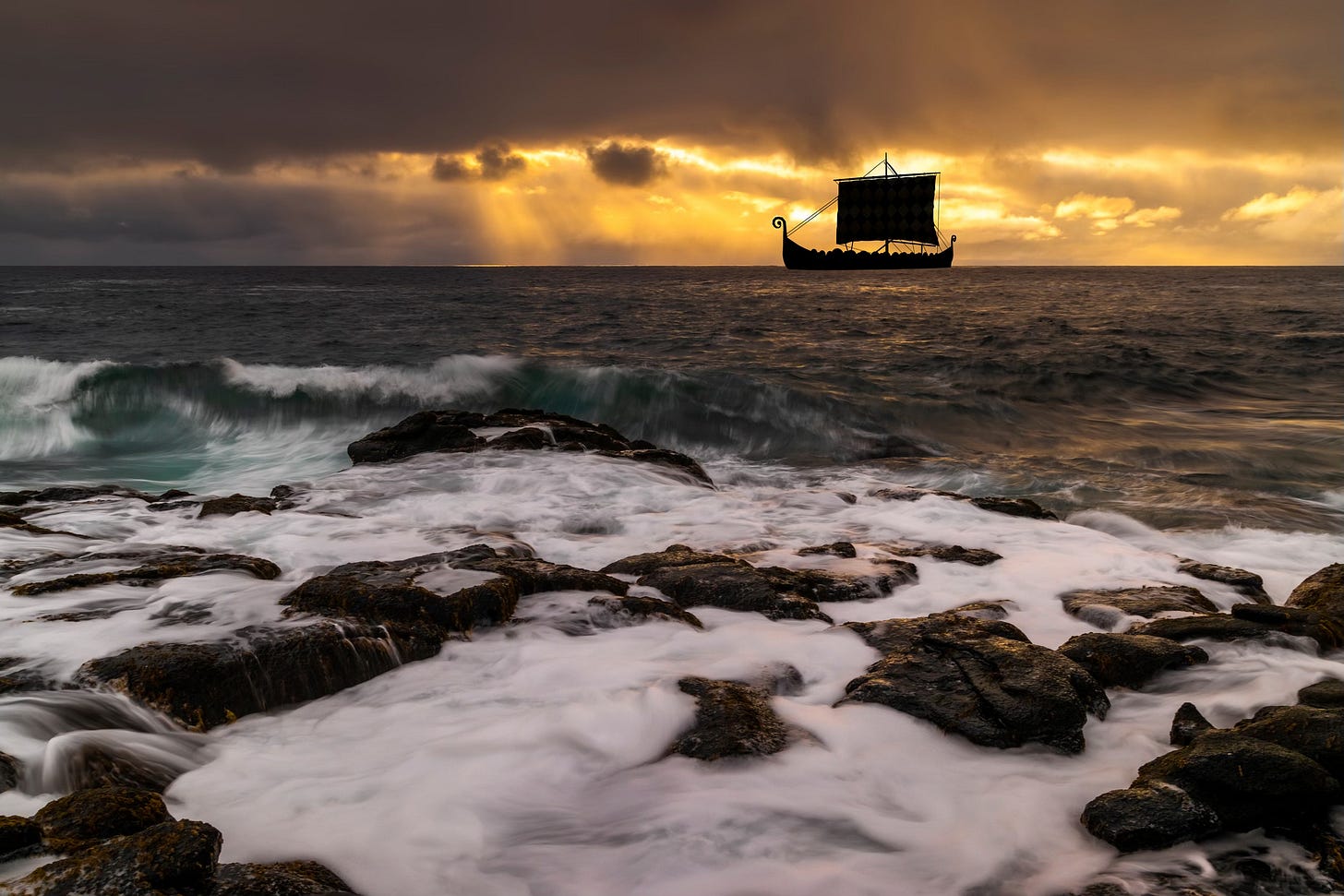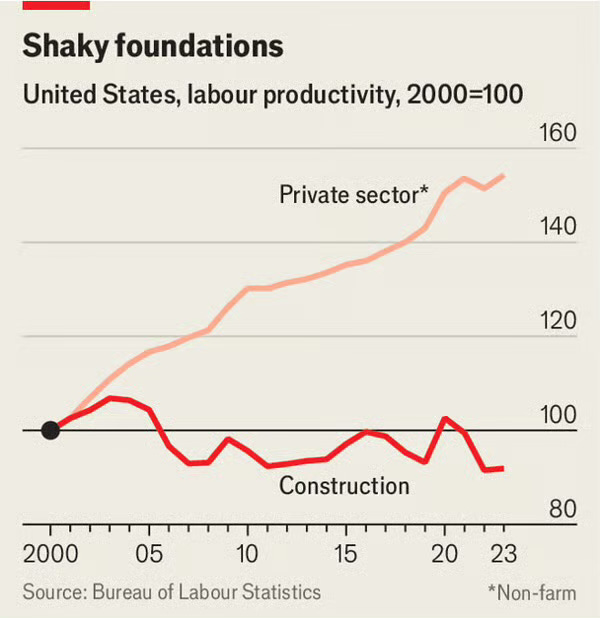TLP Weekend Edition (July 19-20, 2025)
What we're reading and checking out.

🛠️ “America’s broken construction industry is a big problem for Trump: It is beset by fragmentation, overregulation, and underinvestment,” in The Economist. The Economist, following the tradition of "abundance" analysis, scrutinizes President Trump's ambitious economic plans to determine if America's construction capacity is up to the challenge. “But can the country build the factories, warehouses, and bridges needed to reindustrialise, and do so quickly enough?” Currently, probably not:
Yet delays and cost overruns remain inevitable. Productivity has gone from bad to worse. Since 2000, output per worker in the construction industry has fallen by 8 percent, even as it has risen by 54 percent for the private sector as a whole (see chart). The trouble is not limited to commercial projects. America’s house-building companies construct the same number of dwellings per employee as they did nine decades ago, contributing to widespread shortages and soaring prices. Behind this dismal state of affairs is a combination of fragmentation, overregulation, and underinvestment.
🌇 “Welcome to Dallas: The City That Just Can’t Stop Expanding,” by Joshua Chaffin. Speaking of development, thy name is Texas! This fascinating, detailed Wall Street Journal article covers the incredibly rapid development taking place in a corridor north of Dallas. The dynamism fairly leaps off the page. Democrats don’t pay enough attention to the warp and woof of what’s going on in red states. They should.
The growth north of Dallas has been so dizzying that people talk about it as if it were a storm, or some other force of nature.
That’s how Heather Cowan describes it. She came to the area in 1995 to raise a family after graduating from college in South Dakota. Six months ago, she and her husband moved farther north to the quiet of Gunter, 50 miles from Dallas, “to get ahead of the curve,” as she put it. Even in rural Gunter, though, Cowan said she was starting to “feel” the growth.
She was right: The next day, Centurion American Development Group announced it had closed on a thousand-acre parcel in Gunter that would form part of a new development, Platinum Ranch, with 4,200 homes.
The corridor north of Dallas is capping a decade as one of America’s fastest-growing regions, pulling in droves of newcomers from California to India and turning them into newly minted Texans. The companies are coming, too. Among them are Toyota, Amazon Web Services, State Farm and others.
Where cattle once outnumbered people, new shopping malls, housing developments and office towers now reign, and a region that was once overwhelmingly white and country is now increasingly South Asian and techie.
It is also brimming with a kind of morning-in-America confidence. While the struggle to build housing has become a seemingly insoluble crisis in other parts of the country, locals talk about when—not if—Dallas’s northward march will reach Oklahoma.
🫏 "Democrats have only one escape route," by Matt Bai. At a time when many Democrats are trying to unify the party around the idea of embracing a "big tent," the Post's Bai argues that the party must first have a fight about its ideological direction moving forward. He is sympathetic to centrist reformers, but he believes efforts to simply unify in this manner are insufficient for addressing the underlying problems that have prevented the Democrats from defeating Trump twice now, problems that arose from the dominance of a progressive base whose views are often out of step with the rest of the country's. He admonishes recent efforts by Democratic donors and elected officials that invoke the DLC of the early 1990s, reminding them that the DLC took explicit swipes at the party's leftward direction and offered a new way.
First, it evinces a complete misunderstanding of what the DLC was. That group was founded by Al From, a tough-minded legislative aide, and a bevy of other young Democrats who believed—and said outright—that the party had become a prisoner of leftist interest groups and had drifted outside the mainstream of American politics. Yes, the goal was to create an agenda aimed at the broad middle class, but the first order of business was to start and win a bruising fight with the party’s entrenched leadership.
It’s easy to forget this now, given that he has become synonymous with “compromise” in Democratic circles, but when then-Governor Clinton carried the DLC’s message to party dinners and conventions beginning in the late 1980s—challenging Democrats to rethink their positions on issues such as crime, welfare and abortion—he wasn’t seeking some sort of mushy accord with the left. He was going for its jugular.
Second, all the talk about bringing factions together elides a reality that very few Democrats seem willing to publicly confront, even now: The far left has been flat-out wrong on the two broadly most important issues of the day, which was a huge reason Democrats couldn’t get their nominee over the hump last year.
The party’s self-described progressives now proudly embrace the label of socialism as they champion expansive government and vast federal spending, despite the public’s plain distrust in government, and despite the obvious inflationary risks. And the most visible faction on the party’s far left has been obsessed, at least since 2020, with dividing up the electorate by race and ethnicity and gender identity, accompanied by a penchant for shouting down anyone who disagrees.
These twin dogmas might resonate among an affluent cohort of the youngest and loudest American voters, along with the academic left and the leadership of some interest groups, but they are anathema to the broad center of the electorate...
📚 The Long Ships, by Frans Gunnar Bengtsson. Need a break from politics? Check out this epic Viking saga we scored at the “Little Free Library” near Johns Hopkins. Michael Chabon’s enticing prologue tells you all you need to know:
In my career as a reader I have encountered only three people who knew The Long Ships, and all of them, like me, loved it immediately. Four for four: from this tiny but irrefutable sample I dare to extrapolate that this novel, first published in Sweden during the Second World War, stands ready, given the chance, to bring lasting pleasure to every single human being on the face of the earth.
The record of a series of three imaginary but plausible voyages (interrupted by a singularly eventful interlude of hanging around the house) undertaken by a crafty, resourceful, unsentimental and mildly hypochondriacal Norseman named “Red Orm” Tosteson, The Long Ships is itself a kind of novelistic Argos aboard which, like the heroes of a great age, all the strategies deployed by European novelists over the course of the preceding century are united—if not for the first, then perhaps for the very last time. The Dioscuri of 19th-century Realism, factual precision and mundane detail, set sail on The Long Ships with nationalism, medievalism and exoticism for shipmates, brandishing a banner of 19th-century Romance; but among the heroic crew mustered by Frans Bengtsson in his only work of fiction are an irony as harsh and forgiving as anything in Dickens, a wit and skepticism worthy of Stendhal, an epic Tolstoyan sense of the anti-epic, and the Herculean narrative drive, mighty and nimble, of Alexander Dumas. Like half the great European novels it is big, bloody and far-ranging, concerned with war and treasure and the grand deeds of men and kings; like the other half it is intimate and domestic, centered firmly around the seasons and pursuits of village and farm, around weddings and births, around the hearths of woman who see only too keenly through the grand pretensions of men and bloody kings.
It offers, therefore—as you might expect from a novel with the potential to please every literate human being in the entire world—something for everyone, and if until now The Long Ships has languished in the second-hand bins of the English-speaking world, this is certainly through no fault of its author, Frans Bengtsson, whom the reader comes to regard—as we come to regard any reliable, capable and congenial companion in the course of any great novel, adventure, or novel of adventure—as a friend for life.
🎸 When I’m Called, by Jake Xerxes Fussell. TLP was fortunate to see Fussell this past week at Metro Baltimore, where he played excellent old-fashioned-but-not-old-sounding tracks with just his trusty Telecaster. Sweet melodies and mellow fingerpicking make an excellent companion for a lazy summer weekend. Here is Fussell playing the traditional song “Gone to Hilo” for a taste. Enjoy!






The northward expansion of Dallas is undeniably impressive—thousands of new homes, major employers relocating, and a sense of unstoppable momentum. But beneath this growth narrative lies a set of critical omissions that deserve attention. As new subdivisions push into former ranchland, too little is being said about the infrastructure needed to support this pace of development—particularly in areas like transportation, energy resilience, water supply, and long-term municipal services. Roads are congested, public transit is nearly nonexistent, and the deregulated Texas power grid remains vulnerable under increasing strain.
Just as concerning is the lack of investment in “third spaces”—public libraries, parks, community centers, and other civic places where people can gather outside of private homes and commercial zones. Many of these new communities are built with single-use zoning and minimal coordination, resulting in environments that prioritize individual autonomy over public connection. The result is that people go from garage to office park to big box store without ever encountering unmediated public life. It’s a landscape built for consumption, not connection. Texas’s longstanding skepticism of government planning may expedite construction, but it also limits the creation of durable civic infrastructure.
Unchecked growth without coordinated policy isn’t a strength—it’s a risk. If this region wants to remain livable and resilient, it will need more than rooftops and business parks. It will need intentional investment in shared, public space and long-term planning that balances development with community. Otherwise, the northward march may one day resemble not opportunity, but overreach.
The TLP Weekend Edition posts, along with those of Ruy Teixeira are usually the best, most interesting, and ideologically inoffensive things that the TLP team generates. The partisan ideology, and avoidance of truth, has gotten so tiresome, but I guess that’s what you believe your base wants. Anyway, thanks for this one.